-
Posts
1,999 -
Joined
-
Last visited
Content Type
Profiles
Forums
Store
Help Articles
Posts posted by Peter Green
-
-
Bribery helps, I've heard.
"What! Gambling, here in Casablanca?"

Ah, next year should be a good trip.
-
There, now I've got the first three days of the trip done.
What day is this now?.....

-
After all this – dinner
After Fushimi, we trained back to Osaka and made our way to Hankyu for a bit of shopping, mainly camera stuff, and then went hunting for food.
Oh, one observation, just because I love these “Persistent Pursuit of Dainty by World Coffee Company”. I love it when someone has a focus in life.
Our first attempt was to try Rona’s favourite sushi place. It was small, and we’d need to be there pretty much when it opened in order to get a place. However, when we showed the metal grating was down and it was shut up for the day, and wouldn’t be serving that evening.
Such is fate.
So, instead, we worked our way over to Umeda 2 Chome and dropped in on Ginza Kuraodo in the Hilton West Plaza.
We’d really wanted to do Kahala while I was here, but, unfortunately, we weren’t able to get reservations. Oh, well. This would do fine for us.
The restaurant is, in a word, gorgeous. Great views over the town, and a wonderful use of space, with the area broken into numerous nooks and crannies, giving it a much more fun feel than the “big room” they could’ve done.
We sat at the bar, which was fine by me. In addition to the standard wine menu, they also had a promotion going on world wines, which was well worth opeing, as it came as a pop-up.
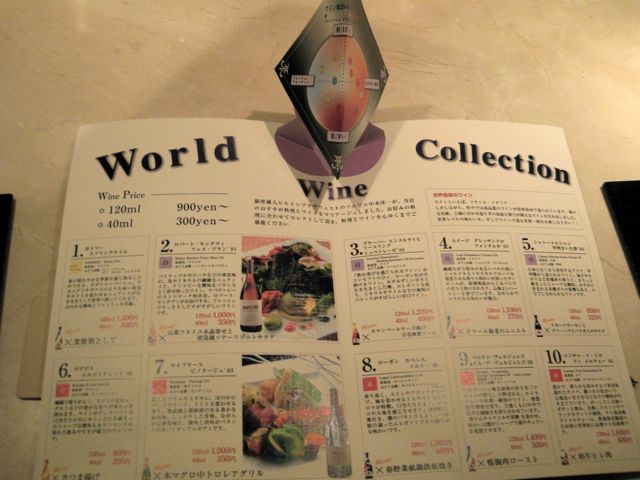
How can you not love a pop-up wine menu?
I must admit, one disappointment……I’d decided, given the décor, that the most appropriate starter would be a martini, but, despite the fact that they had a beautiful bar, with a competent bartender, they didn’t have any vermouth.
What’s the world coming to?
So, instead I returned to the pop-up menu, and chose a glass of the Mondavi Fume Blanc 2005, just for old time’s sakes.
Then, of course, we had to wrestle with the metaphysical issues of “what to order for food?”. This was easy. We saw the foie gras, and went there.
So, we’d decided on the Kirameki course.
Let’s work through it.
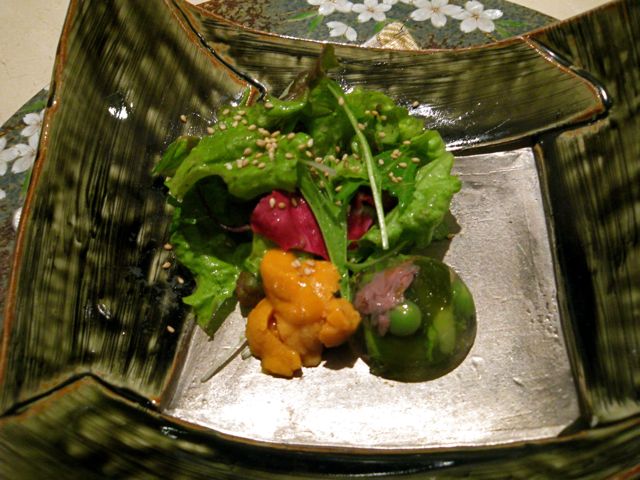
First up was a salad with jellied edible wild plants. This was “alright” the jellied wild plants striking me across the cheek with memories of things at buffets in New Orleans that were in jelly. But the dish was saved by the quality of the salad material, and by the artful addition of uni to the mix.
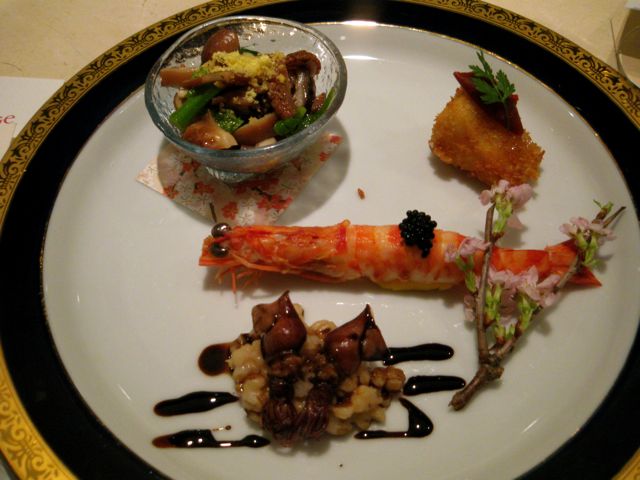
Next came “appetizer”, really a selection of deep-fried camembert with honey sauce (upper right); rape and baby octopus in mustard sauce (upper left); shrimp and yolk sushi with a bit of caviar atop; and squid sauté with a risotto of barley.
The cheese was excellent, full of fat, and just what those of us who have been starved of mammary fluids need to perk us up. The raped octopus (now there’s a name for a band!) was good, but I believe paled in the company it kept, as did the shrimp, of which I can say nothing bad, but it paled beside the squid on the barley risotto. The little tiny squid are so soft, and just squirt as you bite them. And I’ve always been a fan of barley, since Yoonhi started putting it in our rice at home.
I must admit, I did not attempt to eat the branch with the little flowers.
But I was tempted.
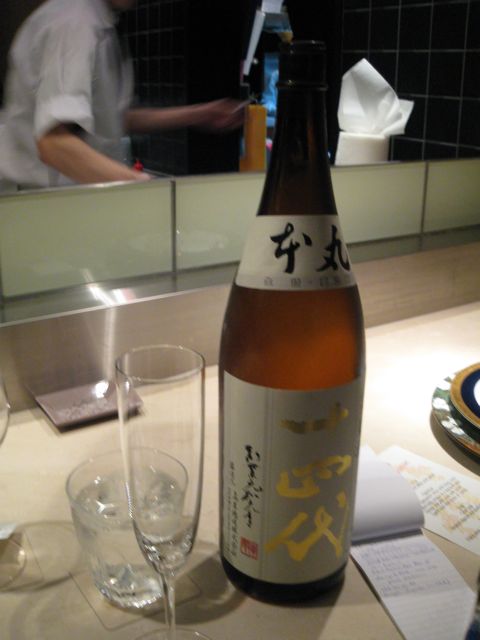
My wine was a thing of the past. And, as much as I admire wine, I was in Japan, and a world of sake lay before me. I asked for something with a full mouth, and was offered a Yamagata Jyuyondai, which tasted very good, rich on the palate.
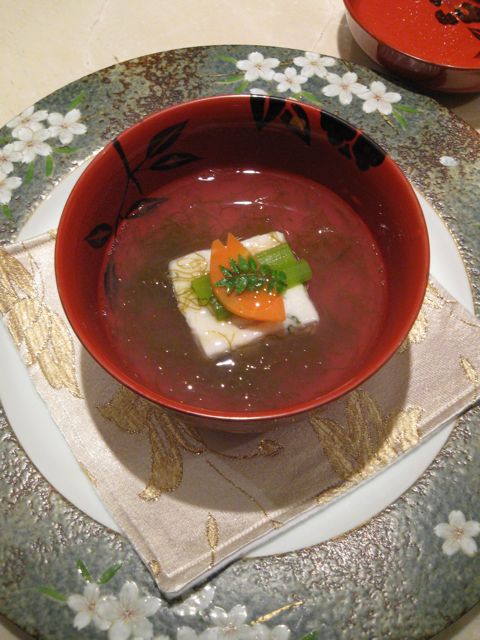
Next was a clear soup of steamed seaweed and a cake of bamboo shoot. It had been topped with an artfully carved bit of carrot, and what we were told were Angelica spears (which is something I’ll need to look up in my Penguin Food Companion when I get home).
I should’ve made the effort to shoot the bowl. I love, as I’ve said, the treasure box aspect of Japanese dining. A beautiful tool (in this case a bowl) used to hide a pretty dish until the last moment. There were hints of gold in the lid, and a presence, set against the gold in the cloth beneath, that could just hold you.
Unfortunately, the dish was perhaps too thickened by the seaweed. It was very sweet, and that, combined with the mucus texture, did not come across quite right for my taste.
But, once the next course came, I forgave them.
Now, you’re going to have to forgive me. You really don’t have much choice. I forgot to take a picture. I was just too excited.
It was a sashimi of horse meat, fluke, horse mackerel, and tuna. The tuna was just alright, with almost a backdrop of ammonia, but the fluke and horse mackerel were fine, and the horse sashimi was wonderful, just the rich, fatty memory I have from Uomasa in Bangkok. Serena’s not going to be happy knowing I eat ponies, but she’s just going to have to deal with it.
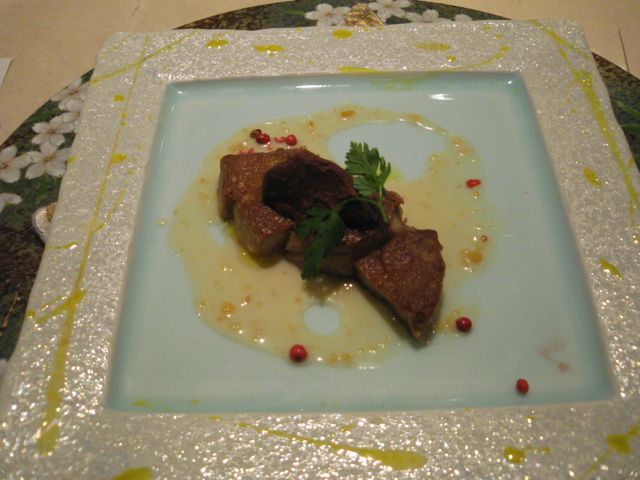
Next, the “Grilled Dish”, a foit gras confit with miso and chocolate sauce. Dotted around it were little dried red peppercorns. We’d asked about these, and were told they were either French, or Malagassy. I’m only used to green Madagascar peppercorns, but, hey, maybe they are from there. They had a wonderful flavour in contrast to the foie, and the chocolate and miso was a very nice backdrop of rich bitterness against the full frontal fat you get from nicely done duck liver.
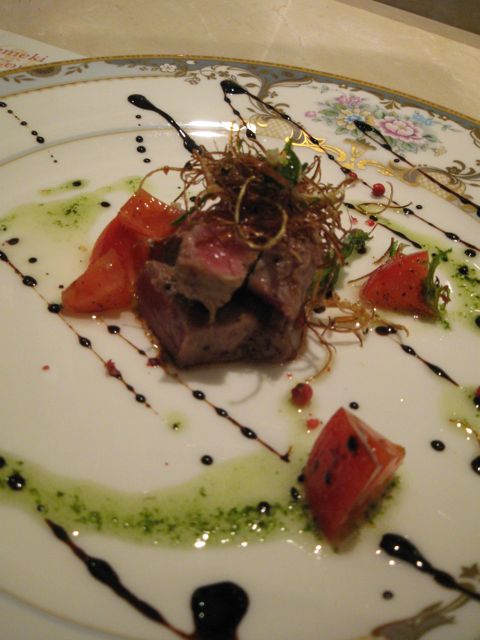
And this was followed by the “seafood”, a big eye tuna that had just been hit with a bit of the grill before being served up with a very tasty tomato, and a windsweep of balsamic and basil sauce. Atop were fried onions.
At this point I found out that Rona is one of those people I love to dine with. She has a small appetite (well, with the exception of baked goods). That means, when she slows down, I can clean up! ☺

The “Refreshment” was a cherry blossom ice cream, which I liked, but Rona found some background of what we thought might be mugwort that she didn’t care for.
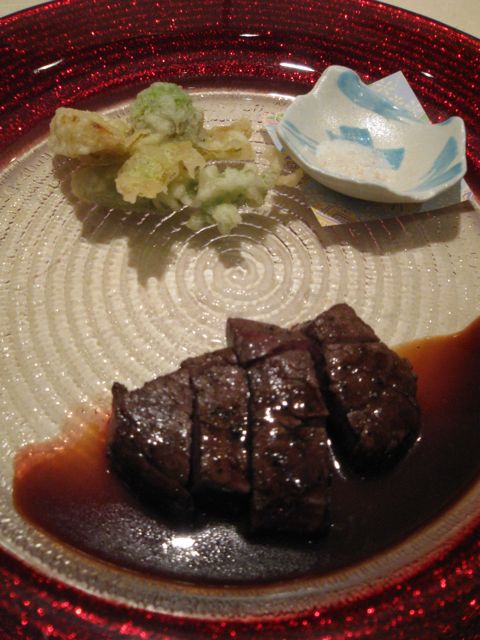
And then, of course, we had to have our “Main Dish”…..or at least, I did. Rona was losing ground, but was holding out for dessert. This was a wagyu fillet with a tempurar of spring vegetables, with rape seed seeming to figure into them in quite a decent manner.
The steak, and its jus, was, of course, really, really good. And Rona couldn’t finish hers.
You don’t mind if I gloat for a bit, do you? (this is, of course, payback for those of you who have been complaining about my laziness in posting).
And after this, more treasure boxes!
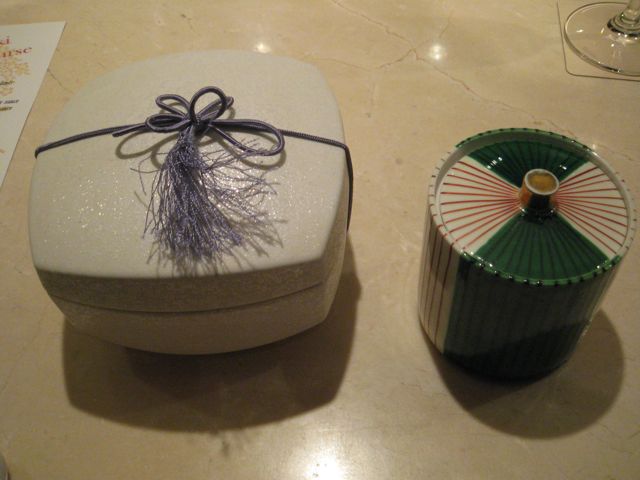
On the right was a miso soup, with yuba, the skin of the tofu, in it.
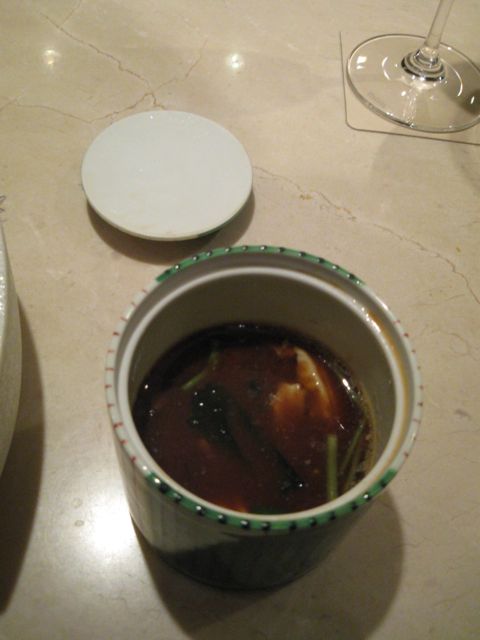
And behind door number two……chirashi zushi.
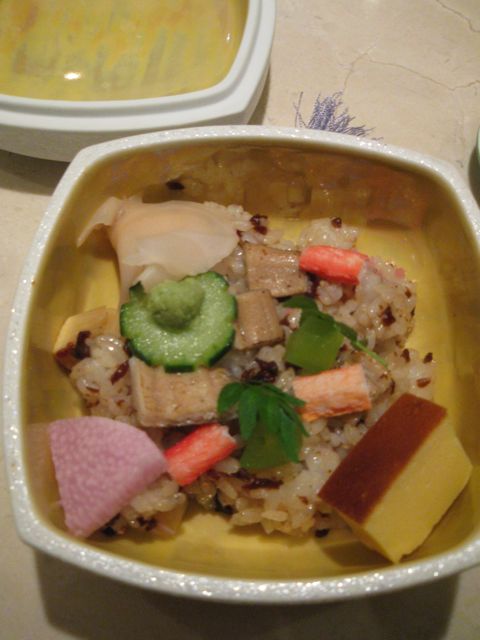
This had a nice piece of egg, some snow crab, other stuff (jump right in!), and, one of my favourites from the Four Seasons’ brunches – eel. All this on rice that I just can’t say no to.
I really do love opening these boxes up.
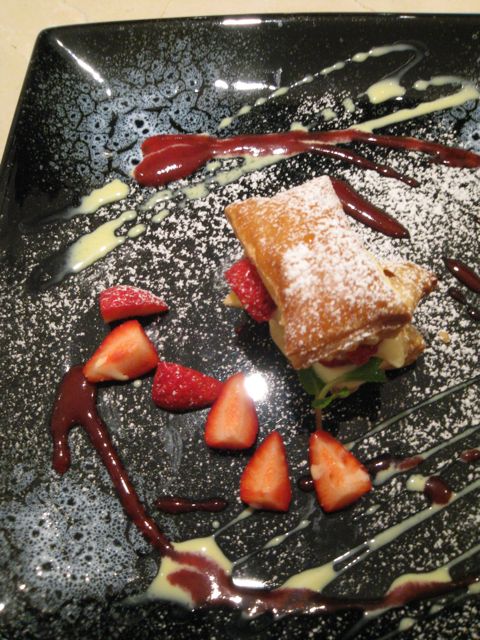
“Dessert” and Rona’s appetite returned. A strawberry pie, that was a layered affair of strawberries, pastry, and some attractive greens (which leaves me out). I think there was a nice bit of cream in there, too, but I’m getting old, and my memory is failing me.
And, I’m already on record defending Japanese strawberries, so I’ll make no further comments.
We finished with coffee

I went with ice coffee, making it an extension of dessert, at least as far as I was concerned. This is something I don’t drink enough of, I must admit, and with a touch of cream and some of the sugar syrup provided, it was very, very pleasant.
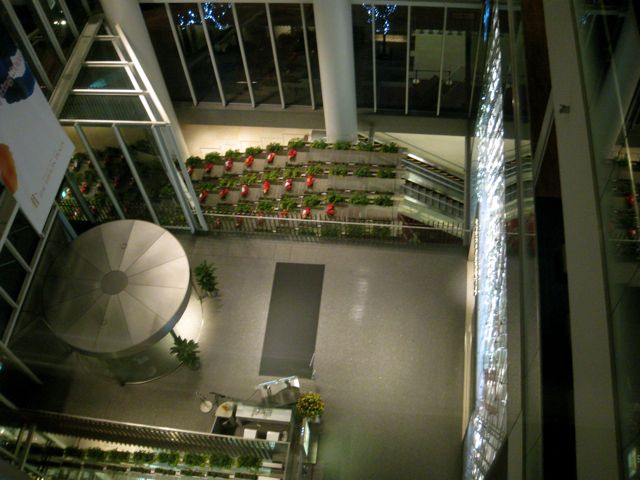
Dinner done, we exited, stage right. It’s a nice building, with what Rona felt were Frank Lloyd Wright influences, but which I see as reflections of Tezuka Osamu’s Metropolis, particularly the 2002 anime, with all the big gears
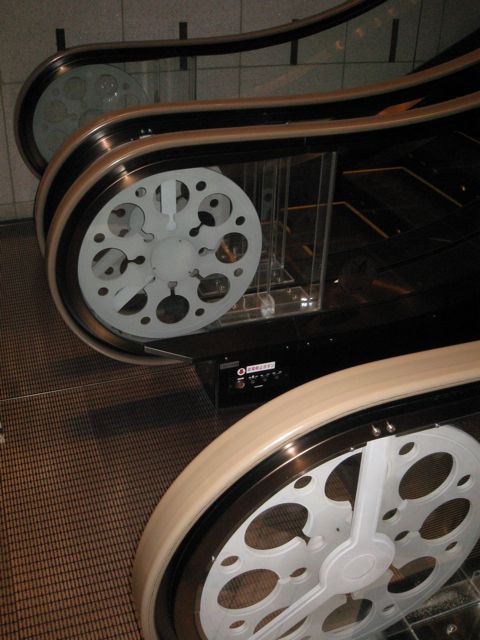
and back lit scenes of the future.
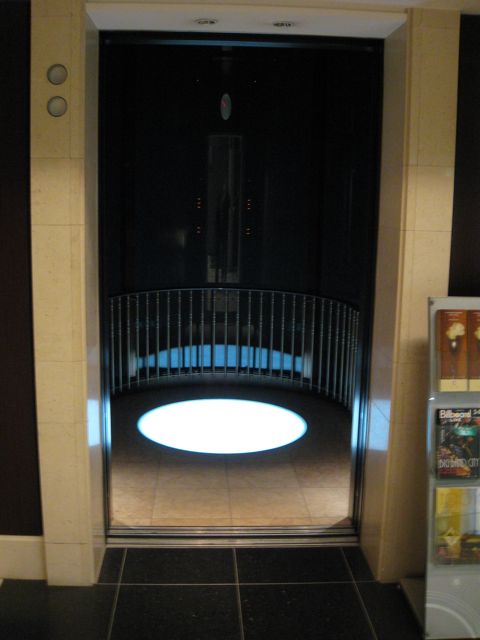
But, all good things come to an end, and Rona headed off for her place, and I made my way back to mine.
Luckily, my friendly vending machine was waiting for me, so that I could get some writing done.
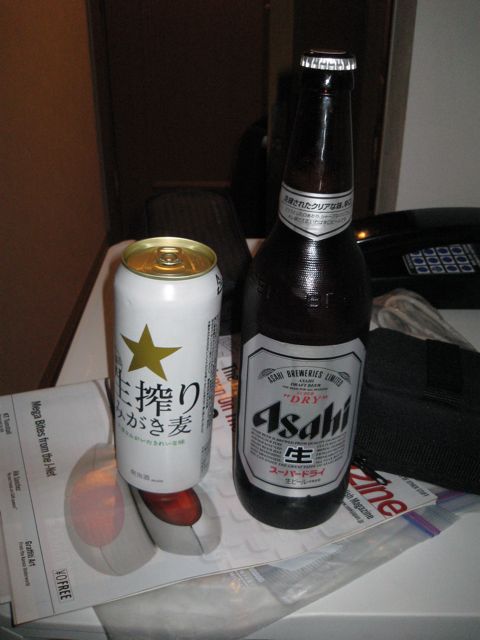
(Can someone tell me what the beer is on the left? I’d think a Sapporo from the star…..I know, you should never take strangers back home……)
-
Okay, I've gotten rid of Scud by sending him to Akibahara with a wad of cash and no social skills. this should buy me enough time for another post.
-
Let me preface this with by saying what needs to be said. If there's something wrong in this, it's because I messed up in pulling things back from the video tapes and notes that I made. So, blame me, and no one else. I've needed to get this done on the road, so I haven't been as strict in my research and checking as I probably should be, and I don't do justice to what I've seen (and tasted) here.
Plus, Scud's been using the computer to read manga.
There, let's get on with the show.
Back to school
I’m lucky sometimes. Really lucky. Maybe it’s in part to this being my year, the Rat, or maybe it’s just the company I keep……but then, isn’t that luck, too?
I was able to spend most of the afternoon with Rona, PekoPeko(from KyotoFoodie), and the Kitagawa family - Chisato (Mrs. Kitagawa), Yukihiro (the President), and Miho (their daughter)- who own the Kitagawahonke Company, which in turn has the Inuigura sake brewery, sake brewers for the last 300 years.
PekoPeko’s already blogged on his previous time here (check out kyoto foodie ), and I’d recommend his writing to you. That will allow me to keep this a bit shorter (although you’re all probably aware that “short” can have a different meaning for me).
After entering and changing to plastic sandals (which is always a challenge for me), we began upstairs, in the classroom. This came with a whiteboard and a/v equipment, and a square of tables for discussion. A good sensible room, both for tours such as this one, and for technical working sessions.
We started with a little history. Sake’s been made in Japan for some 1200 years (others say 2000 years), going back to the founding of Kyoto, and has been made in Fushimi for the last 400 years (since the Edo period), when relative peace was established under the Tokugawa Shogunate. Stability tends to support the development of long term business, and with Fushimi being an administrative center as opposed to the court in Kyoto, the city was in a boom.
The brewery started when a man named Shirobei ran an inn of the name of Funaya, servicing the river traffic (Fushimi was the “port” for Kyoto, handling distribution to Osaka). By 1657 a registry of sake brewers was established, showing 83 sake brewers in Fushimi, with Funaya as an established brewery.
The Kitagawahonke’s brand is Tomio, which comes from Tomi Kore Okina in the Nine Chinese Classics, meaning “old sage”. (Tomio is the Japanese reading of Tomi). Kitagawa Sannemon had chosen the name, as Tomio was seen as a philosopher who held that you’d be a better person if you experienced more.
I’ll drink to that.
Brewing is a tricky business, and is trickier with sake. The base material is sticky/glutinous rice, a rice with lots of starch, low in protein, large in grain, and soft, with a good, pearly body. (As I looked at the samples of the rice, I was wondering how this would work in a risotto.)
The rice is polished, losing a large part, if not most, of its mass. The level of polishing controls, in part, the classification of the sake. We were looking at rice polished to 70%, 65%, and 50% in the display, but they’ll take it down below for 40% for the high end Daiginjyoshu.
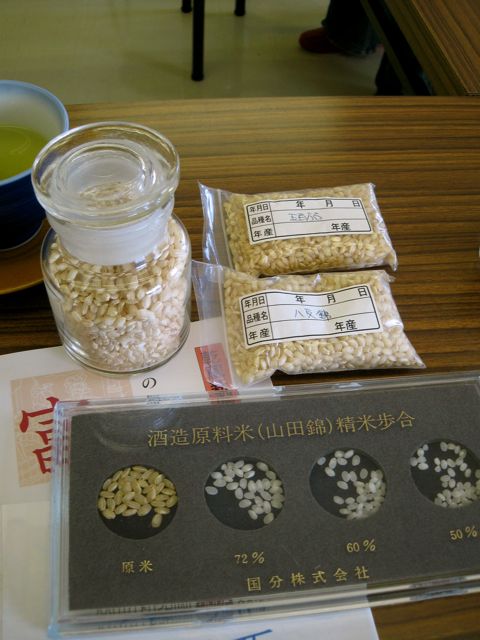
In part, with the more expensive sake, you’re paying for the increased cost of the ingredients. Also you’re paying for a lot more work and dedication in the crafting of the sake, but we’ll get to that.
This talk of rice is all well and good, but the rice has no sugar, so you need a Philosopher’s Stone, to transmute the elements.
Enter the koji. The “national micro-organism of Japan”.
The koji is an enzyme that will act upon the soaked rice to break out the sugars. These then act as the food for the yeast, and there you have an alcohol producing system (do you ever stop, when drinking, to consider that you’re consuming the waste product of a living thing?)
Koji goes beyond just sake, though. It’s also a part of the production of miso, say sauce, nattou (still haven’t eaten any of that) and a range of fermented products. And, of course, there are different kinds of koji, and colours – yellow for sake, black for shochu (modern), and white (the original one for shochu).
The koji, and the water used, is more important than the rice in the production of sake. Like hops for beer. The koji itself is purchased for the brewery through the Japanese Brewers Association. But the brewing of beer is a linear process. Sake is considered a simultaneous ferment, which is what makes it trickier. The koji and the yeast are both together in the vat with the rice, and so, as the enzyme saccharinizes the rice, the yeast can gorge. This means playing a balancing game during the month that things are active.
A growing organism needs something beyond sugar to be healthy (my kids might disagree) and so the quality of the water does play a role. The question here is how soft or hard the water should be, tied to the content of magnesium, potassium, and calcium in the water.
Fushimi (the #2 sake producing district), for its part has about 62 or 63 mg/l of dissolved minerals, and is considered in the middle, or bordering on “soft” or “feminine”, whereas Nada sake (the largest producer) has around 80-90 mg/l of dissolved solids, a “harder”, more “masculine” sake.
Sake is a winter production, after the rice harvest in the Fall is in, and there’s a one month fermenation period, followed by an aging/settling time. This combined takes you to the Fall September/October window as being the best time to enjoy fresh sake, which brings you right back to Winter and getting the next batch ready.
You can age sake, it won’t spoil soon. Aged sake is referred to as koshu, kept for two years or for more than five years (up to 20). This takes on a “sherry” like flavour. And there’s taruzake, which is cask aged, traditionally with Japanese cedar, but the new trend is to utilize French oak and other imported woods to give a different approach to the sake.
You can get fresh namazake that’ll pop when you open the bottle, unpasteurized so that tthe fermentation is still active, the brew still “sparkling”. This is in contrast to a new product, sparkling sake, which is carbonated through a bottom ferment to give a “champagnoise” feel to the beverage. The Kitagawas aren’t producing this, but there’s a lot of effort among other brewers being put into this now with the target being foreign markets.
Oversight of the brewing, and the running of the shop, is handled by the Toji, the brewmaster. In parallel, there is also the owner of the brewery. The owner has the overall control, as it is his responsible to make certain that there’s a market for what they’ll produce.
As I agreed with Yukihiro, it’s good to be the owner.
However, in terms of market, it’s a mixed bag right now. Domestically, sake is losing ground, as beer has been the number one beverage for some time, and the remaining market is being slowly taken over by shochu, which, with a fair bit more alcohol, will get the average salaryman where he’s going a lot quicker.
However, international sales are increasing, with China, Taiwan and the USA showing increasing demand. Then there’s Korea, and there’s growing interest in Europe, with the big wine show in London recently adding sake to their categories, and in the Middle East, with Dubai becoming a target market.
In terms of standings, there’re major competitions for sake. The big one is in May in Hiroshima, where the breweries are allowed to enter one sake. But as a competition, it isn’t so much for a “which single sake is the best” as it is to set the levels for production. Of 500 entries last year, 150 were awarded as gold level. This also, by its nature, is a good opportunity for the brewers to cast an eye over what’s being done in the industry. There are 1300 breweries in Japan, and that’s a lot of competition (even if it is friendly) to keep abreast of.
And internationally there’s competition coming up, with a certain amount of brewing being done in the US (generally under Japanese supervision).
We got out of the classroom and onto the floor. Cool and wet, with a lot of condensation running off through the drains in the floors. The line started at the washing of the rice, and then it came up to the hoppers, where it’s weighted down with cloths and soaked overnight, and then fed into the steamers.
How it’s steamed (for how long, at what temperature) is related to the type of rice used and the target process.
Along side, we got a look at the little controlled room where they prepare and culture the koji (which is the most expensive equipment in the factory).
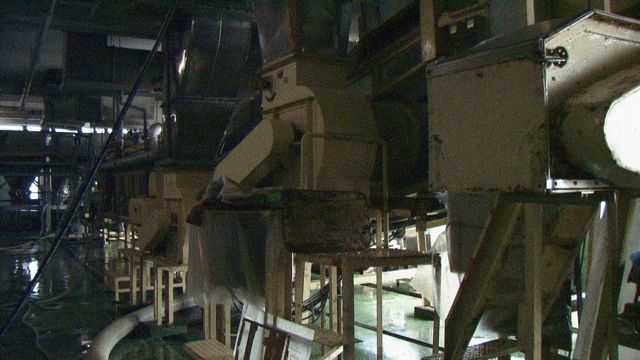
After that, skidding over the wet floors with the drains snowed in with bits of rice, we climbed some battleship stairs and stopped by the vats. We opened up a fresh one with the Daiginju underway (at the 10th day). PekoPeko dropped his head in and gave an immediate “whoa”, and I was a little bit more cautious, picking up the solid aromas of a just opened fermentation tank.
I had a sudden vision of Doug and Bob McKenzie, for some reason.
The sake will stay in these vats for one month under temperature control. They’ll mix it, and if it gets too warm they’ll add in ice. They track the lot, the vat, the date, and the amount of weight in rice. The tank we were looking at had consumed 1.5 tons of rice (polished down to 39%).
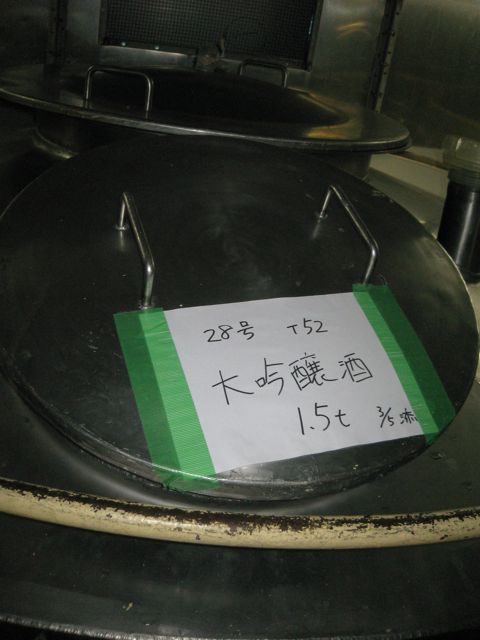
It’s a nice factory to tour. Both if you like pipes and equipment, but also for culture, with little shrines about the place, perched up high, and Shinto notes pasted about.
The factory has a capacity of 1,300 kiloliters. That’s a lot of sake. This we discussed as we walked through the big tanks. We went on top of these to get up on top. There you just see the hatches to the tanks, reminiscent of the scenes from Nausicaa (the manga, not the anime) where the one eyed-critters are held. We pulled off the plastic seals to look down into the bubbling ferment below. There was a rich tapestry of bubles and froth, all with that beige colour that you know is going to make something good.
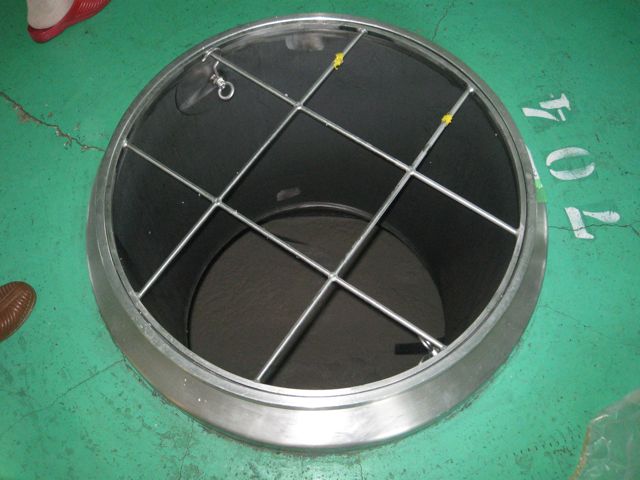
Each of these big boys will hold 6 kiloliters. Down here is Junmaishu, up top was Daiginshu. Out of this you’ll get 10,000 of the big, big bottles that I’ve been admiring in the restaurants.
Temperature control is one of the big concerns in any brewing process, and a separate control room monitors the profile. We could see the variations on the early batches, and compare these with the flatline on the one that was at 27 days now. The barrels are usually about a week apart. There’s also a little clean lab in there for checking for any contamination.
Besides the temperature, contaminants can wreak havoc with brewing. For instance, nattou is banned from sake floors. You can’t eat it before you come in to work here, as the micro-organisms in nattou will kill the ferment. Also, in the past, women were banned from entry, but they’ve eased up on that now (there are two women working on the line now).
To be a Toji (a brewmaster), there’s a certification process required. Some work their way up from the floor, and others go to university (but then still need to work the floor).
If you want to study sake, the places to go were Osaka and Hiroshima universities, but now it’s Tokyo Agricultural University. Osaka and Hiroshima aren’t putting much energy into sake work anymore (there’s more interest in biotech there), so Tokyo pretty much owns the roost now.
The sake production process is understood so there’s not much there. The current work is research on the yeast and koji.
We looked at the two pressing methods. The first was the for the top end process, a large tank with a heavy wooden beam being hand cranked down upon the mass, and the second a large machine sealed off behind accordion doors to be kept at lower temperatures during the pressing.
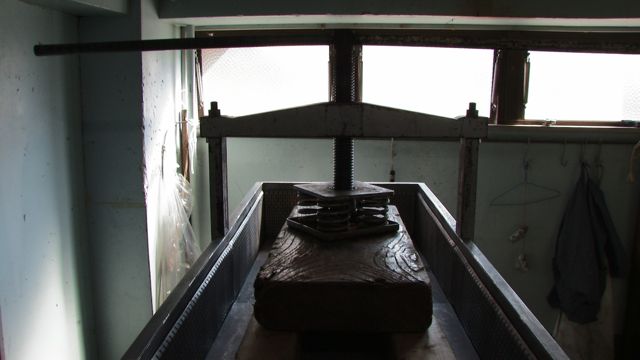
And then, oh joy, we went back to the artisanal press for a pour.
Life seldom gets better than this. We took big tumblers of this and took in the rough and ready aroma of extremely fresh sake, straight out of the press. It’s got a wonderful full flavour. Not as thick in the nose as Korean dongdongju, but that’s what it reminded me of. And the taste, while a little rough, was still good.
I had a big glass.
In the back there was also a cheerfully potbellied still for the making of shochu. The fermented mash is fed in, the tail and head are separated from the process, and there you have it. Here they just work with rice, but the boom in shochu has taken the liquor beyond it’s traditional range of rice, barley, and potato to the current point where almost anything is being done up out there.
They use this to make umeshu here from their own shochu and plums, infusing the plum flavour into the liquor. Rona’s eye’s lit up when they pulled the cover off of the tank holding the plums that had been pulled out of the liquor. “That smells good!” She has designs of dessert, I know.
From there, it was back to the classroom, and, to the delight of Peko and I, there were two bottles out there, a bunch of glasses, and a picture of the straight pour from the press that we’d been testing earlier.
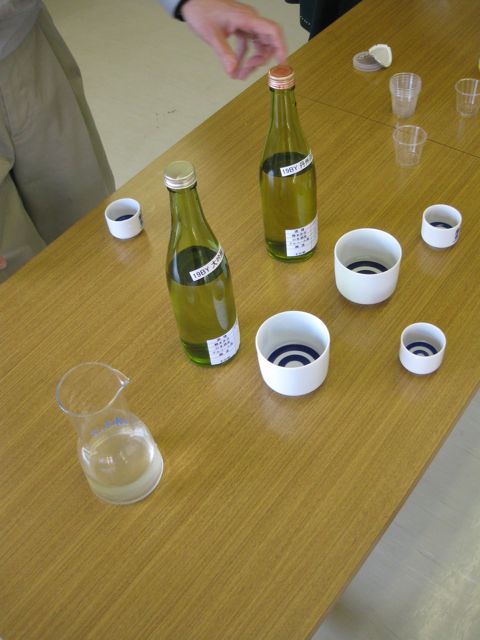
What we were trying was the raw fresh sake from vat 22, a Daiginjyo; a finished Daiginjyo from vat 26 that had been out for one week; and a Junmainginjyo that had been out for 11 days. Of these, the Daiginjyo’s had been worked from rice polished to 39%, while the Junmaiginjyo was at 55%.

I really liked the Daiginjyo, with a beautiful nose on it. But the Junmai was excellent, too, and while it’s bouquet wasn’t up to the Daiginjyo’s, the taste, in Mr. Kitagawa’s estimate, made for better drinking.
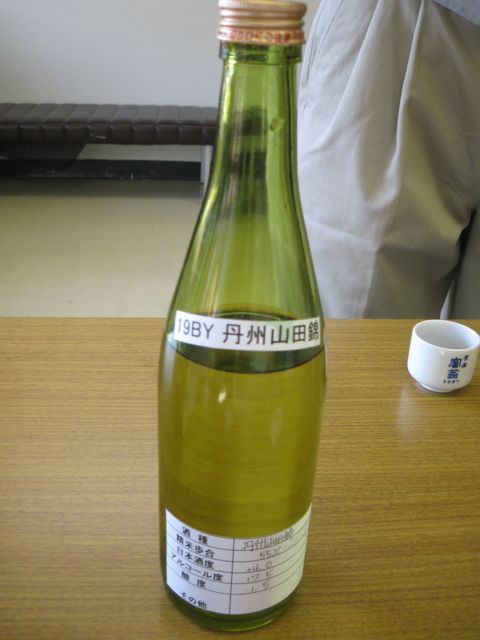
Peko and I had a few more glasses. There was a large stainless steel drain that Yukihiro made use of as he tasted and commented, but Peko and I seemed to miss this.
Comparing the finished product with the very fresh press, you can see how the edges are taken off, and the volatiles settle down. But I still wouldn’t turn up my nose at a glass.
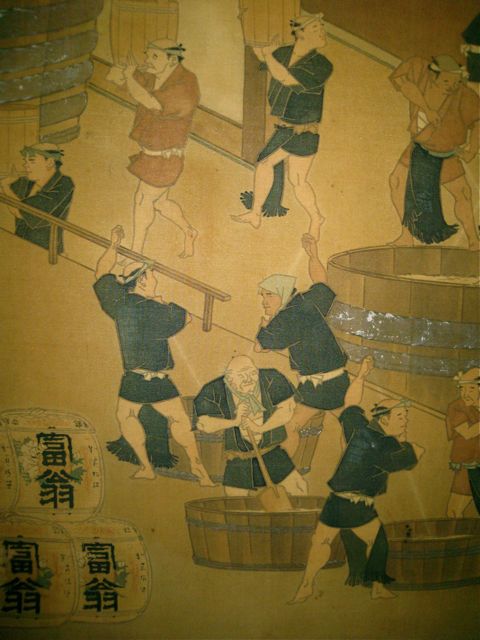
Behind our tasting was a beautiful Meiji era print of the sake process in the Edo period. I was about to say “it’s sobering to think about it” but, given my condition at the time that would’ve been inappropriate – rather, let me say that it gives you reason to respect the old sake makers, as they were working in the barest of clothing, in the wettest of conditions, in the middle of winter to produce material intended for the well-being of all.
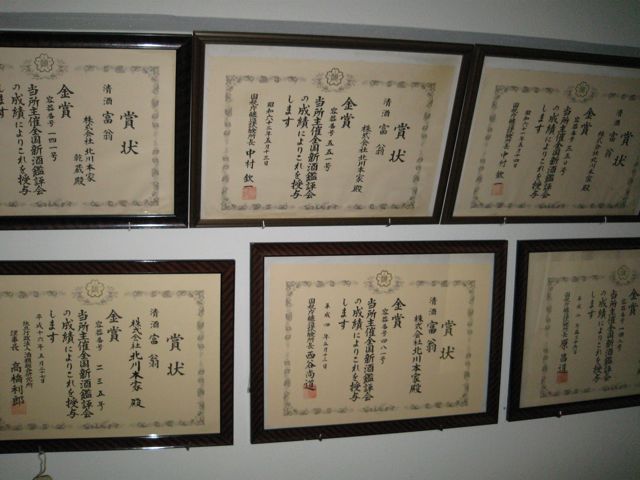
Just outside the door we stopped to admire the numerous awards that Kitagawahonke has won over the years (there are a lot more than I could fit in this one picture). Yukihiro and his family have done well here over the centuries (he just took over as President a few months ago), and when you talk with him the joy he takes in his work comes through clearly. There’s a strong desire to hold with traditions of quality, but there’s also a keen interest in knowing the business and looking for ways to advance the market for quality sake. These are the sort of people you really like to meet as you travel.
Did I mention the part about me being “lucky”?
Next: back to food
note: edited, as expected to fix things that I'd messed up (names - I'm horrible at listening to things)
-
Drinks and dinner (as opposed to dinner and drinks) at Beer Club Popeye's last night.
Forty beers on tap, primarily Japanese micro-brews, and some very tasty hopped sausages.
Dinner tonight at Azuba Kadowaki.
Now I'm waiting for Scud to come fully awake and we're off for Tsukiji with the first train. It's hard getting him started at this time of the day.
Day? I guess it'll be day soon..........

-
It's positively joyful to be here in a culture which is slowly finally getting the money and leisure to revel in eating and going out again!
Reveling is good. I can work with reveling.
Plus, after the Korea trip, I consider ordering food to the house as being "home cooking"!

-
Woohoo!
I'm excited beyond measure that this has come up.
Plus, now I've got a reason for falling behind in my posting!
I want to see all the home cooking, plus, where are you going to get out to?
Cheers,
Peter
-
Okay, I have one clarification,
The restaurant we lunched at was Asada.
For the next part, I'm tormented.
I had an excellent afternoon on the making of sake. But it's not something I want to gloss over. So......give me a bit of time to get farther behind in my food writing, and I''l try to do proper justice to the fine art of brewing.
Cheers,
Peter
p.s. - an excellent dinner tonight at Restaurant Morimoto in Roppongi
p.p.s. - Lupin III is on tv!
-
Sake lees: I think you remember that smallworld made mazake from sake lees.
Got it! I went back and reread Amy's post on her husband making mazake and then remembered it.
Truth was, I was so full of sympathy for him, his wife sneaking a picture of him cooking onto the internet, that I didn't twig to what was being done.
Wait a minute....don't I do that to my family?

P.S. - Hiroyuki, what's the word for quail? It sounded close. I'm curious, as I remember reading somewhere about the Japanese fondness for small birds, and I wonder if they're all grouped together.
-
Peter - what's a tanuki?
Ah, the tanuki. I think this is translated as "racoon dog". I always think of racoons when I see them, as I've lost more than one food cache to them in the bush, and the resemblance is striking, but it's just a resemblance. I looked it up, and they are a canid, more closely related to dogs (which explains the tie to foxes, too).
There's a lot of folklore regarding their lives and actions but my first intro to them was Tom Robbins' Villa Incognito, and I was only reading that because of the Lao connection. Then, when I picked up a copy of Pom Poko, it all made a lot more sense, all the shape-shifting, and their abilityh to glide through the air (I won't go into how they do that here), and their propensity to drink heavily.
Studio Ghibli's Pom Poko takes up the side that shows the tanuki as a fairly happy go lucky sort, who're content to eat themselves to a point of stupefaction, and then have a few drinks to top things off (no comments from those of you who have passed an evening with me!)
Getting way more otaku, Scud points out that in The Decline of Gaming (an online flash cartoon) there was a line of:
"the little racoon suit in the original Mario, why does it allow him to fly? I always thought it would give him the ability to root through garbage cans and look for food"
I could go on a lot longer, but I would be straying from our edict to cover food issues.
Interestingly, the Japanese make a soup from them, and used to use their skins in goldsmithing (and may still do so, given the high regard for tradition we see here).
As seen in Pom Poko, there aren't too many tanuki left about.
-
March 15 – Fushimi
One of the many things that works with egullet is that you get the opportunity to meet people who share your interests. In the case of this trip, I was able to meet up with the Prairie Girl herself, Rona (aka Prasantrin).
We met on the platform at Yodoyabashi station. Rona had been helping out a lot during the planning (if what I do can be called “planning”) of the Osaka trip, and is responsible for all the things that went right. I’m more than capable of getting things to go wrong for myself, so I seldom have to have assistance in that area.
Incredibly, she was able to recognize me in the crowd at the subway. I guess I’m just not blending in as well as I should.
It’s fun to have someone to yack with over food and train rides. Like meeting up with Doddie in Korea, there’s a lot to talk about regarding food and the expat life. It was enough fun that we almost missed out stop.
First on the day’s plan was the shrine at Fushimi Inari-taisha. This is the one with the big red torii that march off into the forest. It’s one of those shots that you always see in the tourist stuff, so I wasn’t about to miss it.
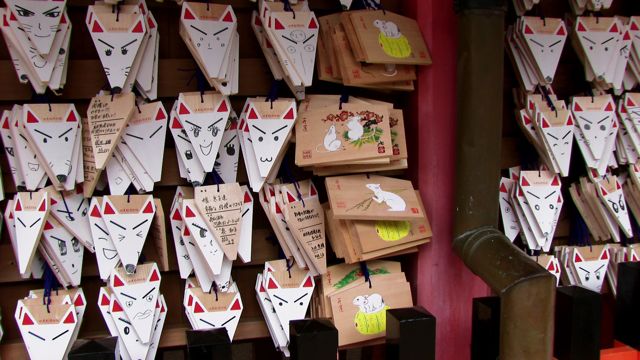
I’d seen the stock photos before, but what I hadn’t appreciated was that the shrine was entwined with fox spirits – kitsune. This was a bonus, as fox spirits play throughout the ghost stories of North East Asia (and in North America, from foxes in the NorthWest to good old Coyote down south).
Foxes also played a role in Pompoko, that great film about the destruction of the tanuki by the spread of urban development. The foxes, sharp as ever, were able to make the shift to living alongside the humans (generally running hostess bars and pachinko parlours) while the tanuki, not quite as sharp, were slowly beaten down.

I’m straying again. I got off on this track as we did come across a tanuki (stuffed) amidst the bits and pieces out on sale in the tourist trap at the foot of the shrine.
The shopping strip is a pleasant enough thing, and we were attracted by the little birds on sticks. At least I was. Rona wasn’t big on the idea of little birds at that point (although we did get to discuss the ortegal topic that’s come up as a tie in to the foie gras bits), so I crunched my way through a quail on my own. We’d really wanted to try the sparrows (suzuru), but they were out, so quail it was.
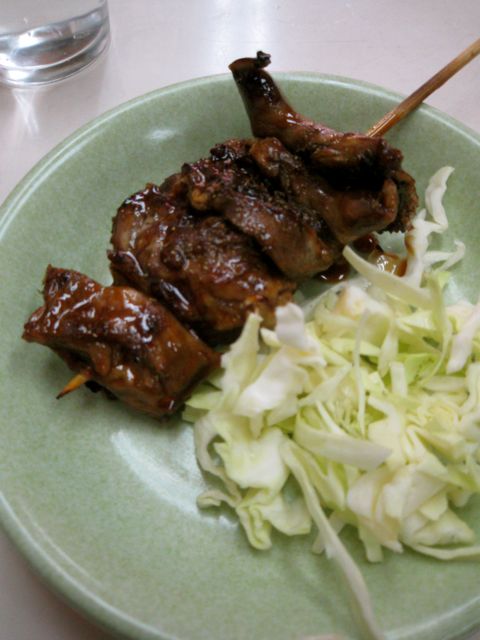
Isn’t it fun coming to countries where you have no idea what you’re supposed to do? I broke down as much of the bird as I could, crashing through the crispy bones, but still had a couple of points where I couldn’t get through without risking some dental work.
“You’re crunching an awful lot.”
I did eat the head, though. Can’t say much about the brains, as a quail’s head is a pretty insubstantial thing (unlike a rabbit’s).
I did also look at some charcoal, of interest to me for filtering. This looked perfect (and it’s purpose was, supposedly, for filtration), but they wouldn’t sell just one piece, and $18 for three pieces of charcoal wasn’t quite my thing.

Rona’s eye was taken in by the cotton candy. How can you say no to cotton candy in a Hello Kitty bag? She has a very detailed high pressure approach to the enjoyment of cotton candy, but I’ll leave that for her to spec out (if she so chooses). I wouldn’t want to give away state secrets.

Second stop was a couple of stops back up the line, more in Fushimi town proper. We were meeting others for lunch, but had a little bit of time to kill, so we ambled down to one of the cafes in the arcade.
Among my first impressions, I can say that Japan is in no apparent shortage of running out of cafes and pastry shops. Rona vouches for the quality of the pastries, and, given her interest in baking (note: you never go hungry around her; there’s always a nice bit of pound cake or a caramel somewhere) I have not the slightest reason to doubt her.

The coffee was acceptable. It was black, and it was hot. That’s enough for me, especially when I haven’t had any caffeine for a day.

We met Rona’s friend and from there made our way to lunch, with a brief look-in on a sake shop. We were curious about what looked like tofu in the bottom middle of this picture. It’s used in soups, the lees of the sake brewing process.

We ate at a very pleasant little restaurant (Rona, what was the name?) where we discussed Victoria and Vancouver – Rona’s friend’s mother having spent some time in Victoria - and from there stretched out into anime and film, and into talk of the Kansai.

Lunch, for me, was a set. A prettily wrapped bento, two onigiri, a bit of layered vegetables, and a soft soup of wee mushrooms.

A bento is always a joy. There’s that mystery just before you open the treasure box. For me it’s just difficult not to rush the matter, but I tried to restrain my eagerness.

Sashimi, egg, sweet potato, yakitori, fish, nigiri, and inside the duck was a little mochi, if I remember correctly.
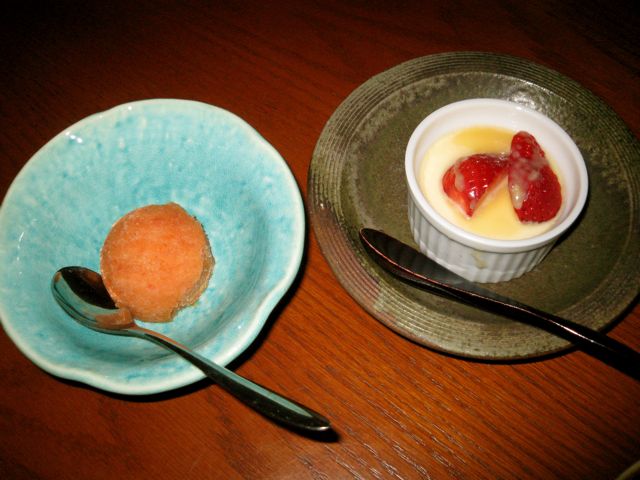
And for dessert there was a sorbet (pumpkin? Rona?) and a custard with two of those strawberries that had been an issue of discussion in Amy's recent blog. For my part, I found them very sweet and pleasant, and quite capable of holding their own with the products of the Okanagan.
After lunch we took a short stroll.
I needed to learn about sake.
Next: classtime
P.S. - as I'm indicating in the asides, please feel free to jump in and correct. Part of egullet is having one of the best sources of proof readers to be had on the face of this planet.
-
It only took a week to finish the first full day! That's not bad, at all!
The little red bottle is shichimi, I think, and to the right of it is nori. Did they have bonito flakes? I never use them, and my favourite okonomiyaki place doesn't, either, but I still see them at okonomiyaki places sometimes.
Did you eat it using the spatula, too? I see a lot of people doing that, but I'm always too afraid of burning myself. Some people say I have a big mouth, but it's more figurative. Really!
Nag, nag, nag.........
I didn't try and eat directly from the spatula for the same reason you gave. It just didn't seem like a wise idea to start a trip off with oral cauterization.
And I'll try to get a little faster. We've come to rest in Tokyo now, and our settings are somewhat more luxurious (which means Scud and I aren't tripping on one another and fighting over the machine).
Back to work. There's research to be done out there.
-
One more thing: Haven't you ever been to konbini in Japan? They sell beers and other alcholic beverages at lower prices than vending machines.
Yup, we're getting some of our stuff from the local convenience stores. They are a better price.
But the beer vending machine is just outside my door!
-
March 14….
Yeah, it’s not over yet.
If you think this travelogue is progressing slowly, you have to understand that I find Tai Chi a fast moving, dynamic sport.
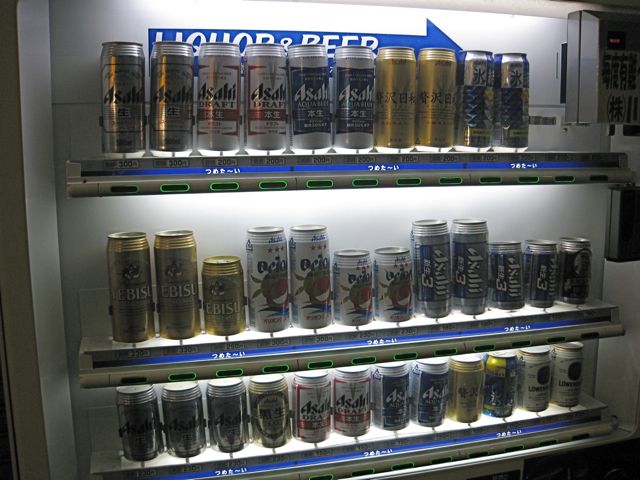
How can you not love a country that vends cold beer every block or so? (And Rona’s told me of more bizarre items in the machines, so I’ll be watching out).
From Den Den Town I had some vague idea of getting to Namba.
In general, I was getting pretty vague by this point.
But just before I made it to the main drag, I found a market on the side. I believe this is the Osaka k\Kuromon (Black Gate) market, where I could’ve seen the pufferfish on sale that I’d been eating earlier.
If it wasn’t closed.
Okay, the market was closed, but that’s not the sort of thing that stops me.
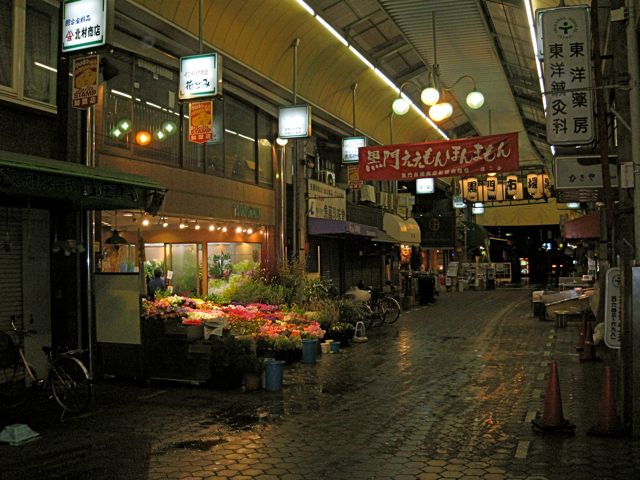
At least the flower shop was still open.
But I needed more than flowers. I needed something I could eat with a shovel.
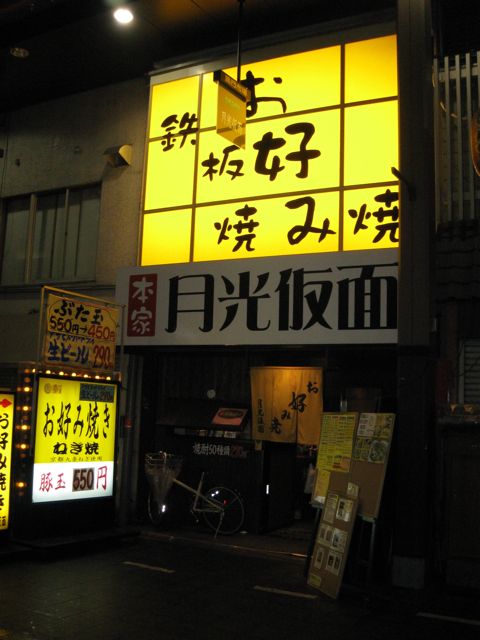
This place appealed to me. It was open. It was empty, but open.
Perhaps empty is just as well, as I was still self-conscious about being completely useless as far as communications went……okay, completely useless, let’s forget about limiting things.
At least I could read enough to know what I was getting. This was an okonomiyaki place.
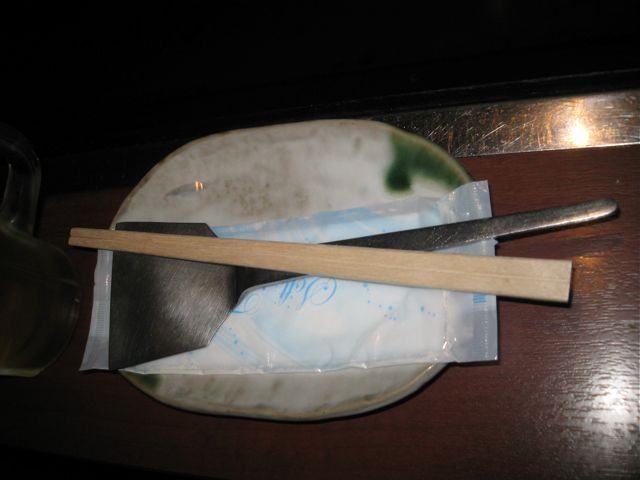
Like I said, sometimes you just need a shovel.
There was a bit of concern regarding what I was going to have. They had a wide selection of ingredients you could use, putting the name of “Japanese pizza” into perspective, this dish allowing you to pretty much play to your heart’s content with what goes into it.
Some places will just give you the stuff, and let you do the work. Here they had everything pretty much done, and presented you with a prepared patty to go on your grill.
The waitress was concerned enough to caution me about leaning on the grill. That would’ve been interesting.
I worked my way around the ordering issue like I usually do, by drawing pictures. No oysters, but they did have squid.

I’ve also learned to say “chotto” when it comes to mayonnaise. The waitress gets pretty aggressive with the squeeze bottle action.
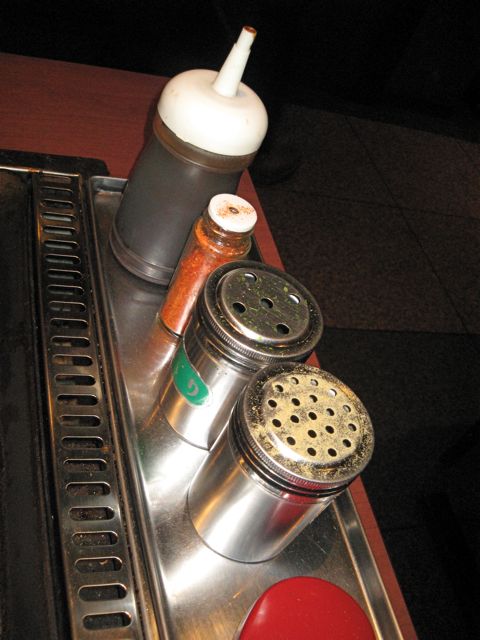
There are fixings on the side. Salt, pepper, more sweet sauce, and some chili flakes, I think? Someone jump in and correct me on that little red shaker there.
While this cooked, I was taking in the TV. I’d been joined by one other young fellow, who was keeping the waitresses in stitches with a steady banter of jokes. The two of us were watching a cooking game show, where the contestants appeared to be trying to guess the cost of the meal. If they failed, they had to pay for everyone.

The okonomiyaki a pretty thing, sizzling there on the grill in front of me. I used my spatula to shove it about a bit, and then, once I’d been given the nod that it should be done, I started in on it, carving pieces off like snow on the walk in midwinter (what do I know of snow? I’ve been in the Gulf for ages)
Not bad. It’s hard to go bad wit grilled battered things. It reminded me a lot of pajeon in Korea, and I wonder as to the origins of the dish, Hideyoshi Toyotomi’s Kansai having benefited from the spoils of the Imjin War, known sometimes in Japan as the Pottery War, from the number of Korean artisans brought back as slaves.

I’d been drinking beer up until now, but there was a nice looking collection of bottles just around the corner of my vision. As I expected, these were shochu, which is getting an interesting lift in popularity these last few years. Beer is still the number one drink, but this is catching up.
After a couple of glasses of cold shochu (potato), I finished up, and then glanced off of the outskirts of Namba on my way back home. There were takoyaki places everywhere, with clusters of diners getting their batter fixes in for the evening.
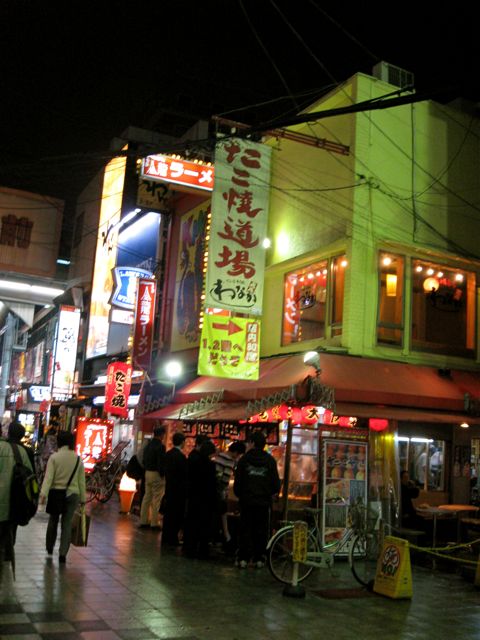
However, as hard as this may be to believe, I didn’t eat any more. I was feeling kind of full.
I’m just a shadow of my former self, I know.
I did have enough foresight to stop by my local vending machine. We’ll be seeing more of this over the next few days. This one, my “bottle shop” (as my landlady put it) was primarily a Kirin and Asahi dispenser.
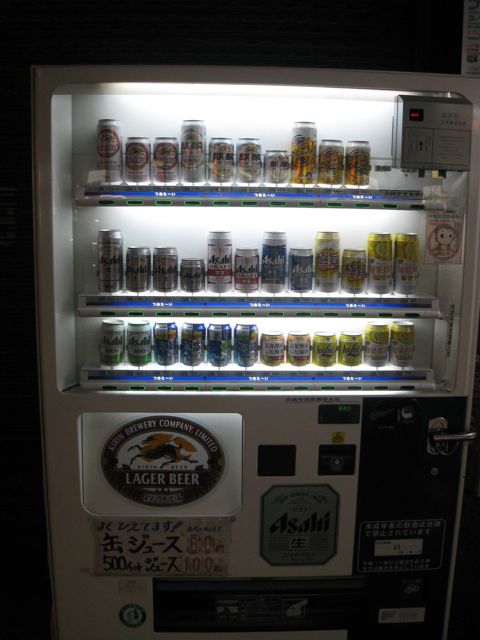
It’s a heartening thing that, after years of having to wait on my beers to chill, these ones came out of the machine cold enough to freeze my fingers as I carried them home.
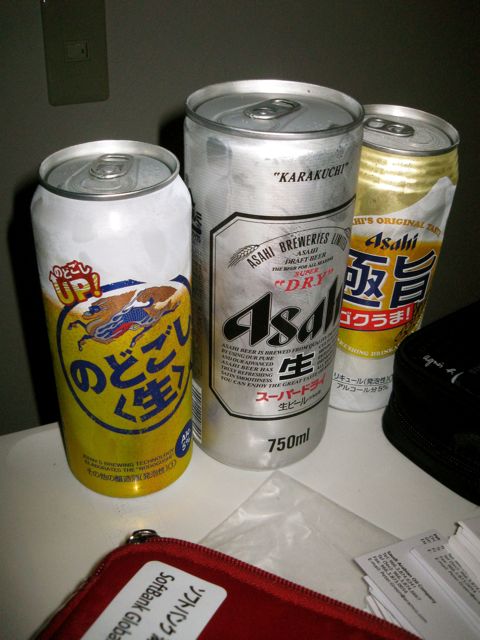
And, so, my 3 friends and I worked on the earlier posts you lot have already gone through.
So much for what was basically Day 1.
Next: Day 2
-
But, Zero Nama isn't even a beer! It's a happou shu!
Okay, I've gotta know! What is "happou shu"? It did say 4%. We just watched an ad on tv of some guy with a completely insane smile who was supposedly revelling in the thrill of Zero.
And, darn, the cherry blossom report says we're going to miss out by a couple of weeks (this sounds oddly like the Korea trip).
Thanks,
Peter
-
Aside
We've now made the move from Osaka to Kyoto. With Rona's help this was relatively painless, resulting in only one run-in with a group of Mozart bound Germans who were in our way, and the loss of a wheel from the most massive of our suitcases.
That's going to be a problem.

Scud had an important comment this morning. The Yebisu Premium All Malt that I had this morning while packing was the beer referenced in Neon Genesis Evangelion when Misato opened a fridge to find it lined with beer.
Because you need to know.
(P.S. - of these two, I preferred the Yebisu over Suntory's 0)
-
March 14 (yet again)
From Shinsekai I wandered on foot, heading into DenDenTown, home of all things electronic (I’d been told).

A haven for the otaku, it’s packed with video game shops as well as hardware sales. The posters for the last Gundam release are still up in prime place, and King of Kings looks down mournfully from the tops of buildings.
And then, just past Den Den Sup;er Potato PC (leading the way in retro tv game revivals) as my attention was snagged by a poster for the Nippombashi Street Fest (scheduled for the 20th, after I’m gone), my ears hear something cooking.
Takoyaki.
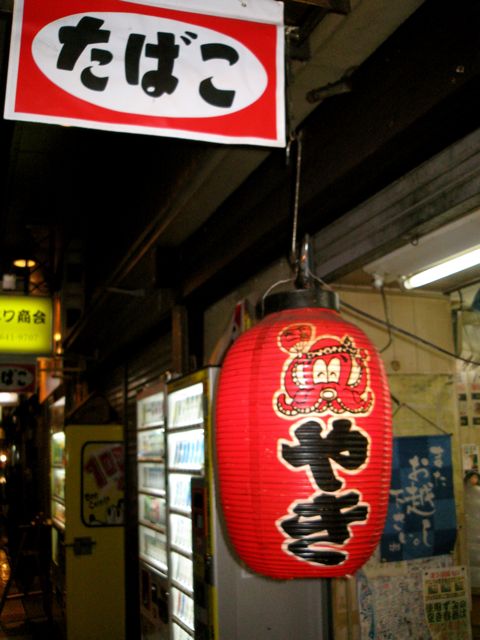
They were sizzling away streetside, the woman working behind a little countertop opening onto the main drag. She was easing the balls out of their molds, and rotating them to finish off the outside.
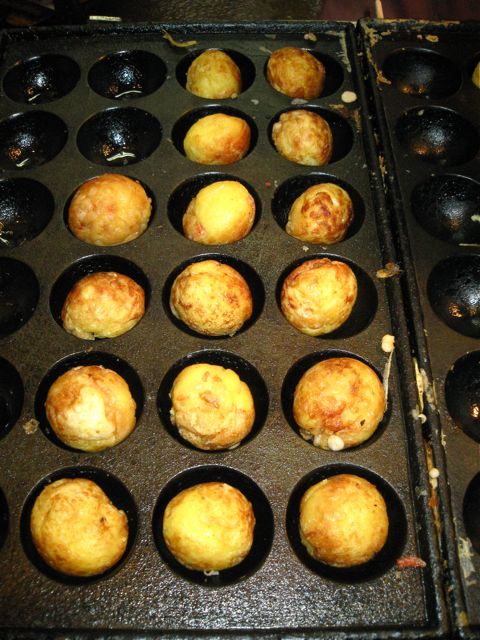
As some of you will recall, I’d been introduced to takoyaki back in Bangkok, having come across a stall outside of Fuji off Sukhumvit.
At the time, I’d been less than thrilled, bitting into a rather desultorily clotted mass of half cooked batter.
But this was different. It was cooked. It was still wet in the middle, but the outside had been settled nicely, and there was a good piece of recognizeable octopus in there to chew on.
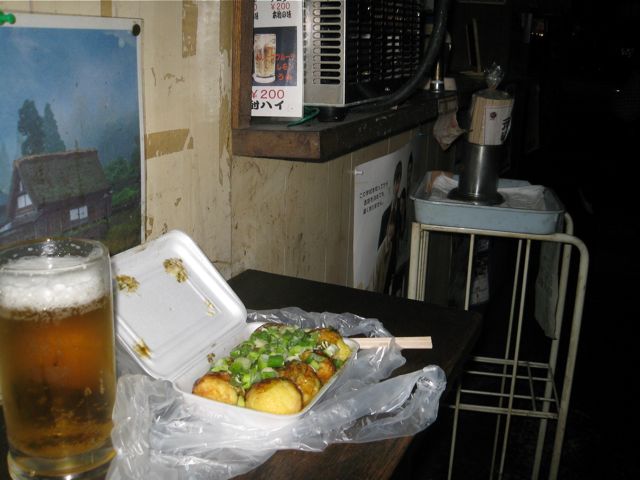
But, food is only part of the restaurant experience. When in Japan, you have to take the time to appreciate the subtle nuances that go into establishing the atmosphere the owners wish to project.
Take for instance the elegantly polished plank of wood at which I was eating, countering the serene prints tacked to the wall, bring back rural memories of yesteryear. Likewise the metal chairs and serving trays introduced an element of the modern.
And, to draw out the literary elements that run through Osaka’s background, with hints of Tanizaki’s The Makioka Sisters' early sections…..we have a copy of Great Teacher Onizuka #1!
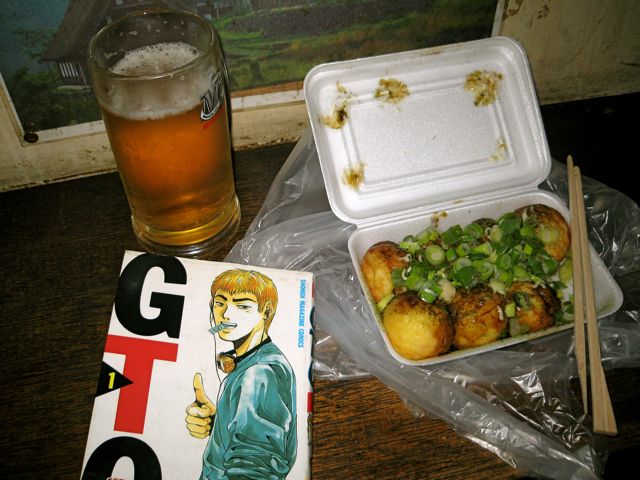
Hmmm….the manga’s quite a bit more lurid than the movie…….
A beer, a Styrofoam pack of takoyaki, and a good, sordid manga, and a run-down hole-in-the-wall (literally). What more can you ask for from life?
I was warming quickly to this city.
Next: still hungry
-
P.S. - I've been eating Men's Pocky, just to reaffirm my virility (wait a minute, this is bitter chocolate, and it's still only as long as a regular Pocky!)
....but isn't it thicker?....seriously...
Nope, just more bitter.
-
Man, it's already the evening of the 17th, and I've only got 1/3 of the way through my first real night's eating.
Here's a synopsis of what's happened, with the details (and pictures to follow):
March 15: a day out with Rona and an upscale dinner
March 16: a lunch with Rona, chocolate with Rona, and then Scud hunting
March 17: a museum, and then a walkabout, dinner, and another walkabout
There. Never say I leave you in the dark.
P.S. - I've been eating Men's Pocky, just to reaffirm my virility (wait a minute, this is bitter chocolate, and it's still only as long as a regular Pocky!)
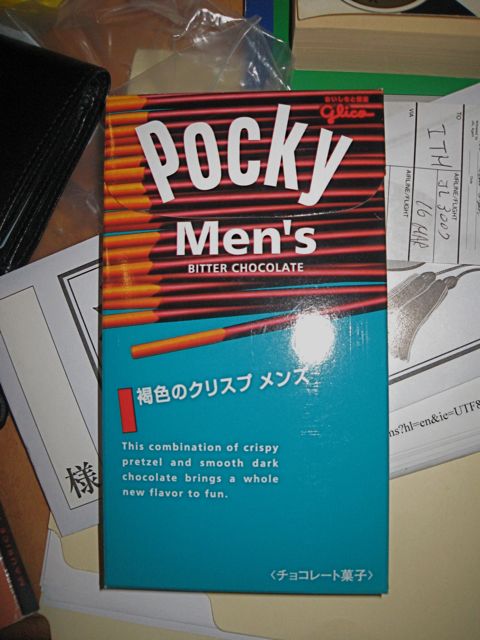
-
Fugu! I wan’t Fugu! doh!
Helen’s post had, as I said seemed a matter of synchronicity, given the Fugu poisoning scene at the start of Le Grand Chef (if you were concerned, don’t be. No food critics were harmed in the making of the film).
It seemed I was predestined.
I was having fugu.
Life’s a lot easier when I don’t have to take responsibility for my choices.
What did I have to go on? I had a name, Zuboraya, and, from the link, I had a map. Okay, the map made pretty much no sense to me, but I had it on good faith that it was close, and that it was in Ebisu.
Let me explain something. My level of research on this trip has been close to nil…..
Okay, it’s pretty much nil. My main concern has been coordinating things so that I have a roof over our heads each night, and so that I actually find Scud at the airport. If I don’t find Scud, I suspect I’ll be in a lot of trouble.
Anyways, I’d settled into my place. There has been some comment, from certain quarters, regarding where I’m staying, but I must say that I find the area has a certain charm.

No transvestites, nobody I noticed missing the last joint of a little finger, but still a certain charm.
My place is next to a number of autobody and fabrication shops so, by the time I was heading out, things were getting pretty quiet. I did a once about to orient myself (and find out where the beer vending machines are) and then made certain I could find my apartment again.
This actually proved pretty tough, so I’m glad I did it. Otherwise I’d we wandering about in the rain late at night trying to figure out where my things were. That’s not a pretty thought.
The second order of business was to get some food. I hadn’t eaten since breakfast, back before 8, and this isn’t going to be much of a food trip if I don’t eat anything. So, as I’ve said, I was looking for Zuboraya.
First I headed across the tracks, and found a sign saying I was at least in the Ebisu area. From there, I headed left, hoping the numbers would get lower.
This worked. As I walked, I kept an eye out down the side streets, something I’d learned from Korea. If there was a street of food, it wouldn’t be on the main drag, it would be down the sides.
I spotted what looked like a likely spot, full of bright lights and a smattering of people, and headed down. The Tower acted as a guide for navigation.
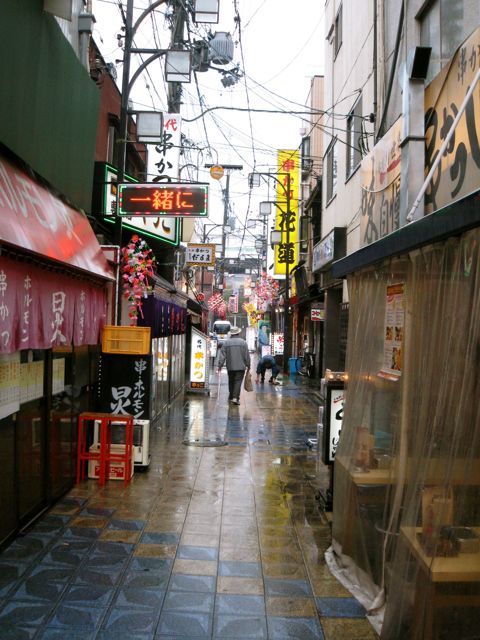
And what do you know? Big pufferfish hanging up in the street just like on the web page.
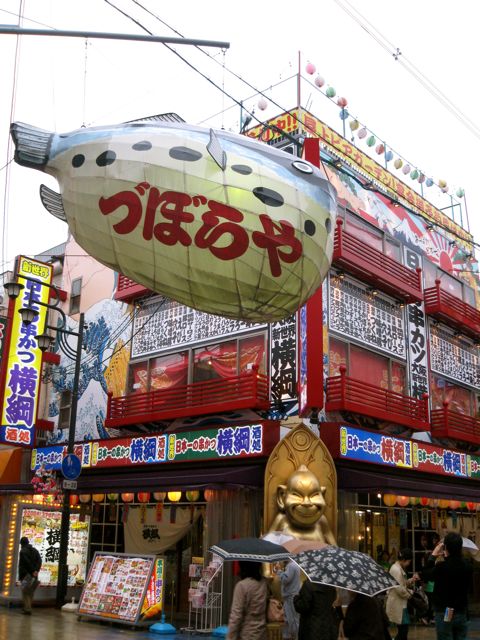
I scouted the 3 Zuboraya places, and then wandered on a bit to see what else there might be. There was an interesting spot just up the street that seemed to specialize in deep frying things on sticks, and there were more than a few sushi places. And some grilling spots.
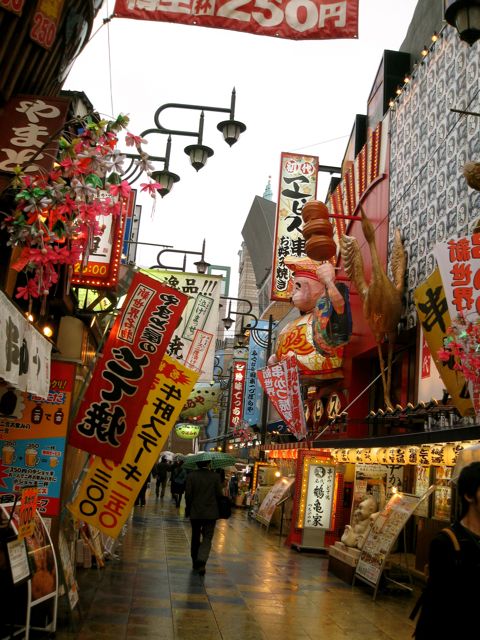
I loved the elaborate nature of the displays attached to the restaurant facades. It had me thinking of Wings of Honeamise, that old classic of space flight (I can’t find it on DVD now, and my VHS version is about to snap, I’m afraid).
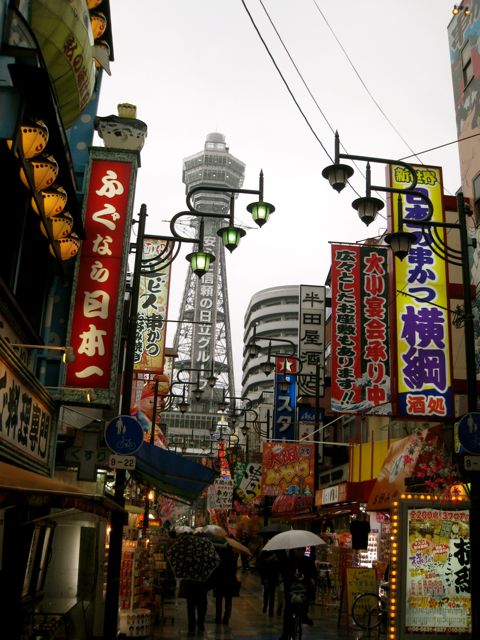
But, I felt it would be to fly in the face of fate not to have fugu. I chose the smallest of the three on the corner, across from the giant Billikin statue.
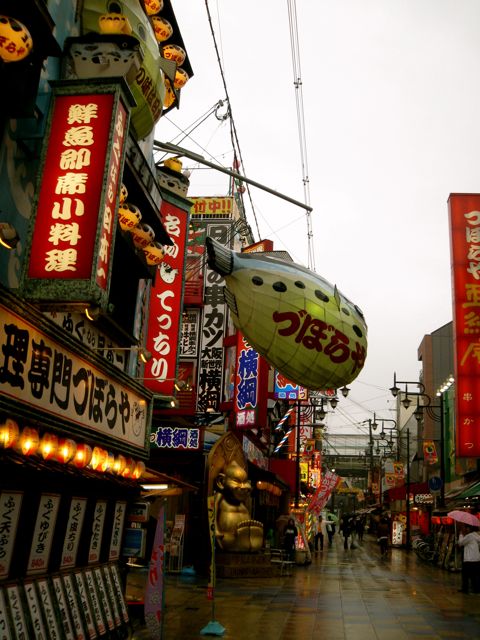
This was my first real meal in Japan. I could not consider the breakfast buffet as a meal, per se. I needed to be on my best behaviour and follow the proper rules of etiquette.
So, when the pleasant middle aged lady ushered me in and asked what I would have, I ordered some sake, and then explained that I was an idiot, and I’d need to go look at the plastic food.
Thank heavens for plastic food (What is the proper Japanese name for the display of food out front?).
I figured that if I went to the most expensive item and ordered that, I would probably be alright.
I was informed that this indeed, fugu, and was served as nabe.
That’s a good start, I figured.
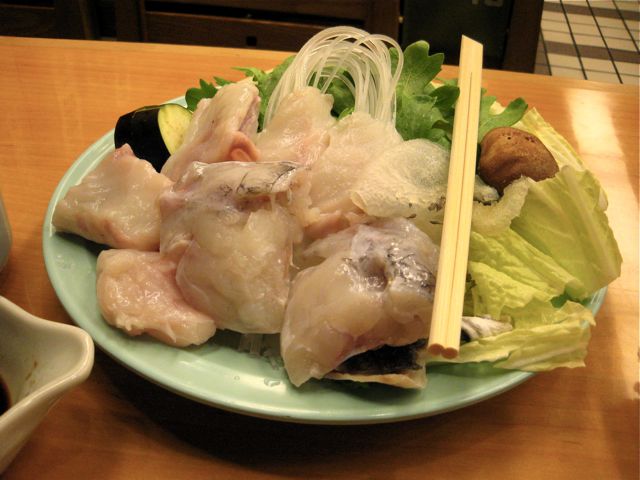
The food came as a very pleasant collection of fish, some bits of meat, and three or four good bony pieces that I assumed would form the backbone of the stock.
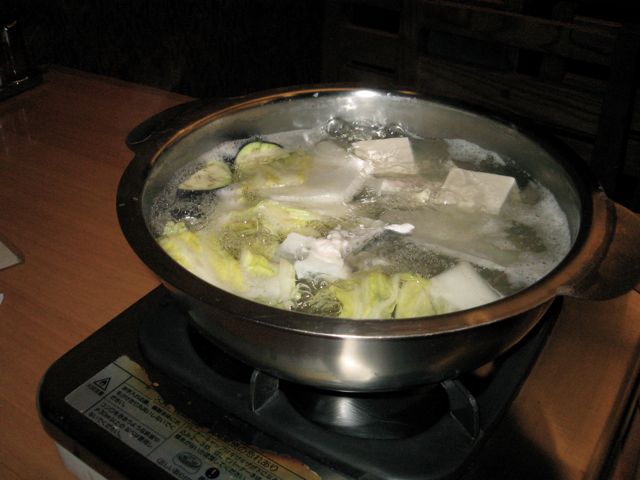
The pot came to a boil, and my hostess removed the piece of whatever it was (seaweed?) from the broth, and then put the bones in, the vegetables (radish, cabbage), and then the tofu. Then, once at heat again, the fish meat was lightly cooked, and eaten with a mixed sauce of spring onion and ginger (in soy and vinegar?).
This kept me busy, as did the sake that I worked through. But, as I believe in variety, and I needed to rehydrate, I decided to try some shochu in the mix as well.

What a happy decsion that was, as a “gurasu” (glass) of shochu is much more like a half pint. This is the way to drink shochu. None of these little shot glasses that need to be filled up again and again.
I suppose next I’ll be moving onto one of those backpack siphon systems……
I finished the first stage of the nabe, and then the very patient lady came by to move the rest of the vegetables and the noodles into the pot, and then let it and still felt that there was room for more. My reading was enough that I could recognize a sign on the wall for fugu tataki (no kanji in that to struggle with), so I ventured an order.
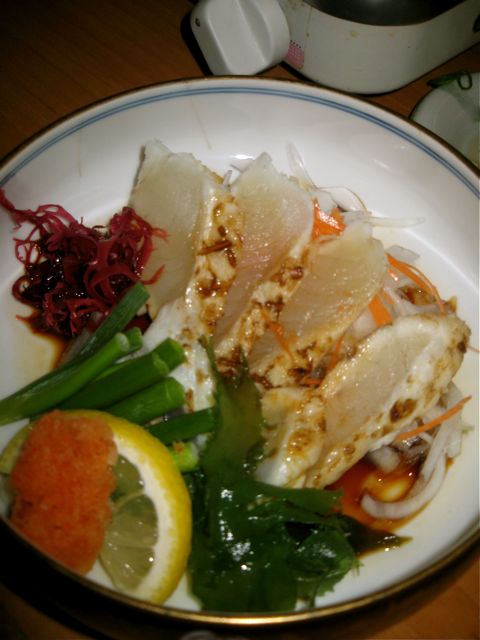
I much preferred this. Perhaps just that this is more in my comfort zone. The meat was nice and chewy, but not overly rubbery as I’ve had in the past.
Of course, that just got me going. One of the tables nearby had filled up, and I’d noticed that they’d ordered nigirizush, so I felt safe in asking for that.
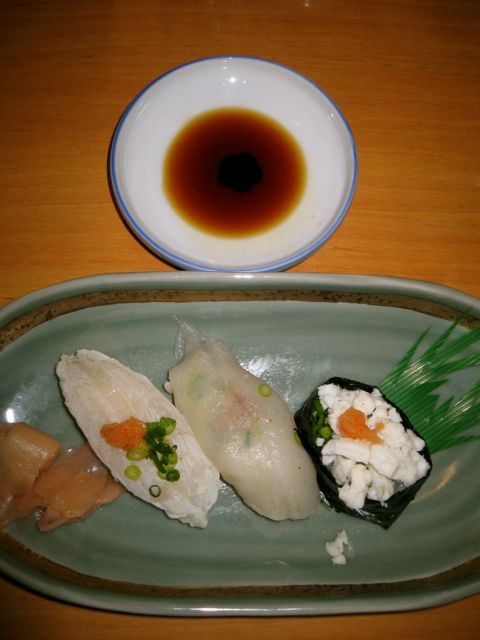
The three pieces represented a nice cross section of fugu meat. Of the three, I’d say my heart was with the mince on the right, that having a good, fishy flavour.
Across from me, a pair of older gentlemen were enjoying a different nabe, into which the waitress was crumbling nori.
With the sushi, a beer (a Suntory), and then turned my thoughts to the important matters in life.
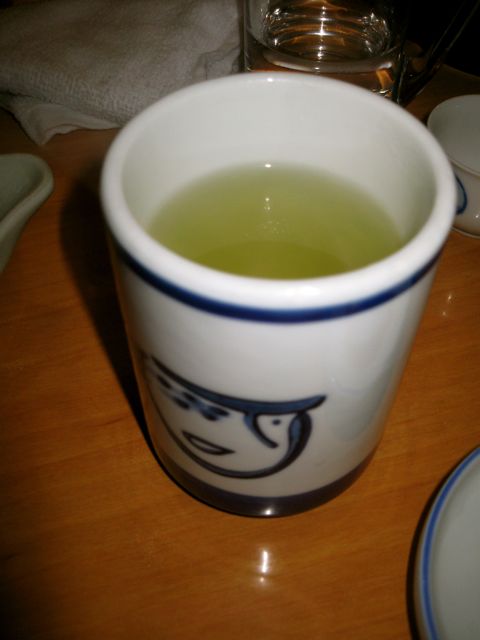
Like my cup of tea. What a pretty colour.
And then, of the greatest importance……would I eat next?
Next: Peter moves on to Phase II
-
Peter,
You mentioned that having a tattoo is one sure way to get ostracized in japan. Might one inquire if you are speaking from experience?
And why is it so? The Yakuza gangsta connection? The You-have-AIDS-because-of-dirty-needles-in-tattoo-shops?
Just curious...
Nope, there's not a tattoo on me...scars, yes, tattoos, no. I have a pretty clear idea of what Yoonhi would do to me if I went for a tattoo session.
But, as Hiroyuki confirms, yes, it is the yakuza connection. Tattoos and gangsters are closely tied together in the east (and in the west there's a strong connection with prison tattoos identifying who's done time). Jason (my nephew) had told me that tattoo parlours weren't allowed in Korea for that very reason, basically to keep the gangs pinned down a bit (at least in one aspect).
Unfortunately, none of this has much to do with food. I'd better get back to posting.
On the good news side, The Boy made it here in one piece, with all of his luggage, so it appears we're off to a safe start.
Now I just need to find time to write.
-
Welcome to Japan!
Congee is okayu おかゆ お粥.
Tatoos are closely associated with yakuza.
Bowing good manners? You can see people bowing everywhere in Japan.

Thanks very much, Hiroyuki! I've been looking forward to this trip. And I hope you'll follow along, as I'm going to have a lot of
But, I do think that bowing is good manners. If everyone does it, then it's a very good thing.
By the way, why does everyone here whisper when they talk about they yakuza?
Oh, another question, have they always put the Pocky inside the box in separate foil containers? I remember buying Pocky in Canada, and you just opened the box.
Cheers,
Peter
-
March 14 (just two mornings ago)
You’d like to arrive at a destination with tales of discovery and grandeur.
Instead, I was at a Hilton.
It had been a long day. I’d been traveling since leaving work the day before, and it was already after 9 p.m. when I checked in.
I suppose I could’ve pushed on from Narita, but it seemed far wiser to get a night’s rest and be ready for the ‘morrow. So, after a brief tour of the hotel (and finding that the pool’s hours, as expected, weren’t going to coincide with mine, I did something I don’t usually do.
I skipped the bar and went to sleep.
Shocking, eh?
I usually dread hotel breakfasts, but this morning was not a problem. A nice piece of fried salmon, some very glutinous fried rice, properly prepared bacon (not burnt to a crisp), and, best of all, the traditional fry of mushrooms included little tobikos.
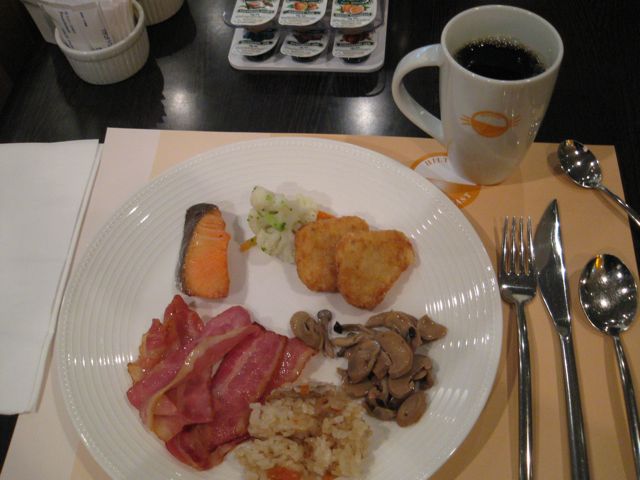
On the bread front, I had no complaints regarding the croissant; flaky, not the boiled thing we see in hotels in the Middle East (there is no other way to describe the glotty texture of what gets put onto a baked goods tray in North Africa and the Gulf). And, better than croissants, they had sweet bean buns. You can tell what it is by the heft of the thing, that layer of pale goop in the bottom giving it a wonderful balance in your hand. If you’re ever involved in a major food fight in Asia in at a hotel breakfast buffet, go for the sweet bean buns.
That was a bit of advice you needed, right?
Where was I? Breakfast….there was also a congee (what’s the Japanese word for congee?) station, with enough condiments to keep Yoonhi happy, and a soup. But I wasn’t quite ready for that yet. What I needed was coffee, and I was content to work my way through a couple of pots while checking out the paper.
After breakfast it was fold things up, pull aside clothes for a day, and check out. I would skip the gym, as my main interest is swimming, and I wasn’t about to use up two more hours here waiting. Plus, the health club has strict rules on not allowing anyone in with hotels, so there wasn’t going to be much of an opportunity for sightseeing.
I found out later that having a tattoo in Japan is a great way to be ostracized. No onsen, no health clubs, not much of anything is open for you. What would happen to Angelina Jolie?
Before leaving, I had my luggage forwarded. This is a great service, saving me the sweatbath effort of hauling 20+kg of suitcase around behind me in the morning. The bellhop had a station with a sign of two black cats, a mother carrying a kitten in its mouth. For about $15 I had my burden taken off of my hands, and only a piece of paper to carry in its place.
My plan involved me getting back to the airport, renting cell phones, and then getting the train to Osaka. En route, we were advised to have our passports ready, as there would be a checkpoint on the way. When we hit it, there was a large illuminated sign advising that the Chiba police were on a full anti-terrorism alert. This state of tense intrusion of security was played out by their politely stopping cars, boarding busses, checking passport photos, and then bowing to everyone.
I really do like good manners.
The phones went without a hitch, with me picking up two. I checked and, unlike Seoul, I can return these at the departures level office, rather than having to go to the exact same booth.
And the train booking was simple, the young lady putting my connections through Tokyo station onto the #83 Nozomi to Shin Osaka.
Piece of cake.
And so I found myself entrained, detached, and wrapped up in images outside the window; a splash of colour from a plum tree coming into bloom; a stand of bamboo, some 30’ in height, shifting in the wind from the train; a large pagoda pushing its head up like Godzilla from behind a brand new Aeon shopping mall in Narita Town; a small citrus tree of some sort with bright orange fruit (too small for oranges, though), grows apparently untended by the station.
The cart lady comes through, quietly announcing the availability of coffee. Her tray is loaded with Pocky and bags of snack foods. When she finishes her trip through our car, she turns and bows.
Outside, the compounds of houses have given way to the first of the boxes of apartment blocks. The buildings are all getting taller, and soon the fields are gone and we’re into the suburbs of Tokyo. A skyline of telephone poles and power lines against a sky of low clouds, just now letting loose with drizzle.
The transfer in Tokyo is a little nerve wracking, but, as everyone has time to help, it would seem, I’m directed in stages to the right platform for my train.
And then the exit from the city is performed in reverse but over a longer period of time, it being a long, continual stretch of megalopolis for quite some time. I try to use my phone to call ahead to confirm my arrival, but the tunnels on this stretch give me about a two minute window in which to try and figure out what the person on the other end is saying.
I figure I’ll wait, and call when I’m there.
Did I mention manners? You don’t use your phone in the compartment, but go to the back section, through the doors and by the toilets. People would take their silent phones, glance nervously at the displays, bow, and race to the back. No threat of having the person next to you screaming at this office beside your ear.
Past Nagoya I see the Knorr and Ajinomoto factories cheek by jowl as we speed past.
The Dream Pub, a square box of a building in the middle of open fields, perhaps half a kilometer to the nearest house.
The trolley lady does another pass, and the lady next to me has a nice bento, a wooden box with cardboard top, with mushrooms, peas, scallops and rice. Some pickled ginger too.
At Kyoto, the rain is beating down even more, now. A relentless Vancouver like misery that puts me in the mind of Witch Hunter Robin and long trench coats.
And, at least, we approach Shin Osaka. From here I finally phone my landlady, and takem my instructions on how to get to Dobutsuen-mae. The subway system for tickets is similar enough to the Korean and Thai that it’s not too much of a bother to get my ticket, and from there it’s a few minutes on the red line to where I need to be.
I arise from the underground at the Festival Exit, an entrance of stylized waves. Above me I can see a rollercoaster track perched up on the building. Samantha comes from the apartment to meet me, and I’m where I’m supposed to be at last.
Next: Finally some food pictures



Travelogue: Spirited Away
in Japan: Dining
Posted
Rona, you know better than I. What would you say?